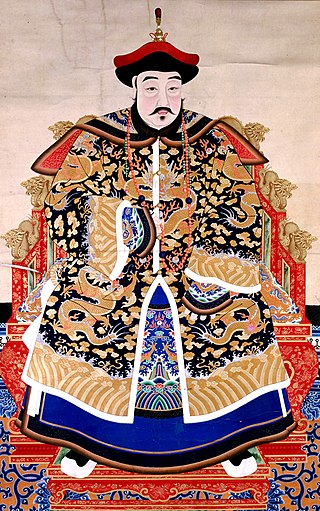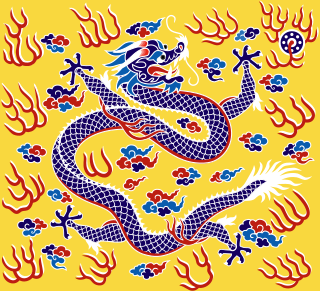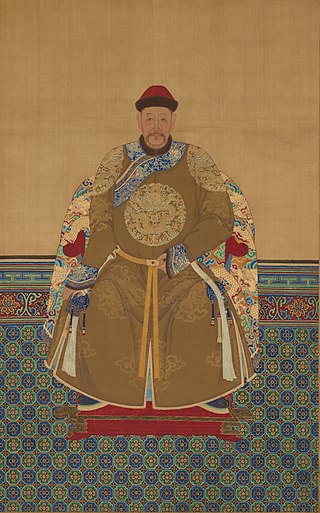The Manchus are a Tungusic East Asian ethnic group native to Manchuria in Northeast Asia. They are an officially recognized ethnic minority in China and the people from whom Manchuria derives its name. The Later Jin (1616–1636) and Qing (1636–1912) dynasties of China were established and ruled by the Manchus, who are descended from the Jurchen people who earlier established the Jin dynasty (1115–1234) in northern China. Manchus form the largest branch of the Tungusic peoples and are distributed throughout China, forming the fourth largest ethnic group in the country. They can be found in 31 Chinese provincial regions. Among them, Liaoning has the largest population and Hebei, Heilongjiang, Jilin, Inner Mongolia and Beijing have over 100,000 Manchu residents. About half of the population live in Liaoning and one-fifth in Hebei. There are a number of Manchu autonomous counties in China, such as Xinbin, Xiuyan, Qinglong, Fengning, Yitong, Qingyuan, Weichang, Kuancheng, Benxi, Kuandian, Huanren, Fengcheng, Beizhen and over 300 Manchu towns and townships. Manchus are the largest minority group in China without an autonomous region.

Dorgon, was a Manchu prince and regent of the early Qing dynasty. Born in the House of Aisin-Gioro as the 14th son of Nurhaci, Dorgon started his career in military campaigns against the Mongols, the Koreans, and the Ming dynasty during the reign of Hong Taiji who succeeded their father.
The Eight Banners were administrative and military divisions under the Later Jin and Qing dynasties of China into which all Manchu households were placed. In war, the Eight Banners functioned as armies, but the banner system was also the basic organizational framework of all of Manchu society. Created in the early 17th century by Nurhaci, the banner armies played an instrumental role in his unification of the fragmented Jurchen people and in the Qing dynasty's conquest of the Ming dynasty.

The Shunzhi Emperor was the second emperor of the Qing dynasty of China, and the first Qing emperor to rule over China proper, reigning from 1644 to 1661. A committee of Manchu princes chose him to succeed his father, Hong Taiji (1592–1643), in September 1643, when he was five years old. The princes also appointed two co-regents: Dorgon (1612–1650), the 14th son of the Qing dynasty's founder Nurhaci (1559–1626), and Jirgalang (1599–1655), one of Nurhaci's nephews, both of whom were members of the Qing imperial clan.

Hong Taiji, also rendered as Huang Taiji and sometimes referred to as Abahai in Western literature, also known by his temple name as the Emperor Taizong of Qing, was the second khan of the Later Jin dynasty and the founding emperor of the Qing dynasty. He was responsible for consolidating the empire that his father Nurhaci had founded and laid the groundwork for the conquest of the Ming dynasty, although he died before this was accomplished. He was also responsible for changing the name of the Jurchen ethnicity to "Manchu" in 1635, and changing the name of his dynasty from "Great Jin" to "Great Qing" in 1636. The Qing dynasty lasted until 1912.

Dodo, formally known as Prince Yu, was a Manchu prince and military general of the early Qing dynasty.

The House of Aisin-Gioro was a Manchu clan that ruled the Later Jin dynasty (1616–1636), the Qing dynasty (1636–1912), and Manchukuo (1932–1945) in the history of China. Under the Ming dynasty, members of the Aisin Gioro clan served as chiefs of the Jianzhou Jurchens, one of the three major Jurchen tribes at this time. Qing bannermen passed through the gates of the Great Wall in 1644, conquered the short-lived Shun dynasty and the Southern Ming dynasty. The Qing dynasty later expanded into other adjacent regions, including Xinjiang, Tibet, Outer Mongolia, and Taiwan, gaining total control of China. The dynasty reached its zenith during the High Qing era and under the Qianlong Emperor, who reigned from 1735 to 1796. This reign was followed by a century of gradual decline.

Ebilun was a Manchu noble and warrior of the Niohuru clan, most famous for being one of the Four Regents assisting the young Kangxi Emperor from 1661 to 1667, during the early Qing dynasty (1644–1912). A largely passive figure during the regency, Ebilun was disgraced following the ouster of the far more powerful regent Oboi and considered a political supporter of the latter. He was stripped of his positions by the emperor but later regained his noble rank. Many of his descendants became influential figures in the Qing imperial government.
The Seven Grievances was a manifesto announced by Nurhaci, khan of the Later Jin, on the thirteenth day of the fourth lunar month in the third year of the Tianming era of his reign; 7 May 1618. It effectively declared war against the Ming dynasty.
Ajige was a Manchu prince and military general of the early Qing dynasty. He was born in the Aisin Gioro clan as the 12th son of Nurhaci, the khan of the Later Jin dynasty.

The Plain Yellow Banner was one of the Eight Banners of Manchu military and society during the Later Jin and Qing dynasty of China. The Plain Yellow Banner was one of three "upper" banner armies under the direct command of the emperor himself, and one of the four "right wing" banners. The Plain Yellow Banner was the original banner commanded personally by Nurhaci. The Plain Yellow Banner and the Bordered Yellow Banner were split from each other in 1615, when the troops of the original four banner armies were divided into eight by adding a bordered variant to each banner's design. After Nurhaci's death, his son Hong Taiji became khan, and took control of both yellow banners. Later, the Shunzhi Emperor took over the Plain White Banner after the death of his regent, Dorgon, to whom it previously belonged. From that point forward, the emperor directly controlled three "upper" banners, as opposed to the other five "lower" banners.

Daišan was an influential Manchu prince and statesman of the Qing dynasty.
Jirgalang or Jirhalang was a Manchu noble, regent, and political and military leader of the early Qing dynasty. Born in the Aisin Gioro clan, he was the sixth son of Šurhaci, a younger brother of Nurhaci, the founder of the Qing dynasty. From 1638 to 1643, he took part in many military campaigns that helped destroy the Ming dynasty. After the death of Huangtaiji in September 1643, Jirgalang became one of the young Shunzhi Emperor's two co-regents, but he soon yielded most political power to co-regent Dorgon in October 1644. Dorgon eventually purged him of his regent title in 1647. After Dorgon died in 1650, Jirgalang led an effort to clean the government of Dorgon's supporters. Jirgalang was one of ten "princes of the first rank" (和碩親王) whose descendants were made "iron-cap" princes (鐵帽子王), who had the right to transmit their princely titles to their direct male descendants perpetually.

Nurhaci, also known by his temple name as the Emperor Taizu of Qing, was the founding khan of the Jurchen Later Jin dynasty of China from 1616 to 1626.
Amin was a Manchu noble and an important military and political leader in the early years of the Qing dynasty.

The transition from Ming to Qing or the Manchu conquest of China from 1618 to 1683 saw the transition between two major dynasties in Chinese history. It was a decades-long conflict between the emerging Qing dynasty, the incumbent Ming dynasty, and several smaller factions. It ended with the consolidation of Qing rule, and the fall of the Ming and several other factions.
Eidu was a Manchu officer and a member of the Niohuru clan.
Shamanism was the dominant religion of the Jurchen people of northeast Asia and of their descendants, the Manchu people. As early as the Jin dynasty (1115–1234), the Jurchens conducted shamanic ceremonies at shrines called tangse. There were two kinds of shamans: those who entered in a trance and let themselves be possessed by the spirits, and those who conducted regular sacrifices to heaven, to a clan's ancestors, or to the clan's protective spirits.
Identity in China was strongly dependent on the Eight Banner system during the Manchu-led Qing dynasty (1644–1912). China consisted of multiple ethnic groups, of which the Han, Mongols and Manchus participated in the banner system. Identity, however, was defined much more by culture, language and participation in the military until the Qianlong Emperor resurrected the ethnic classifications.










